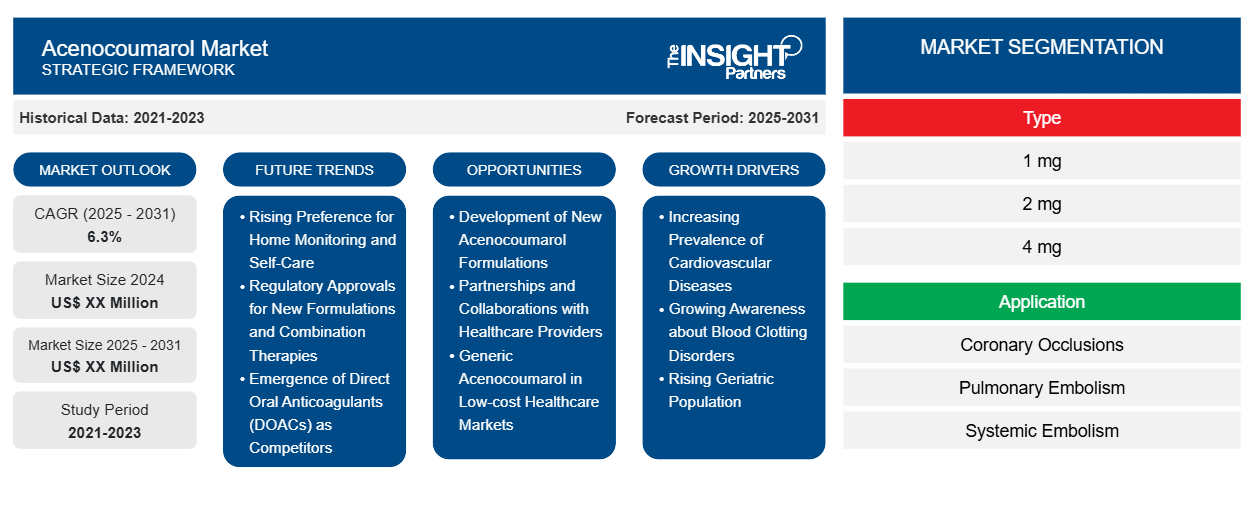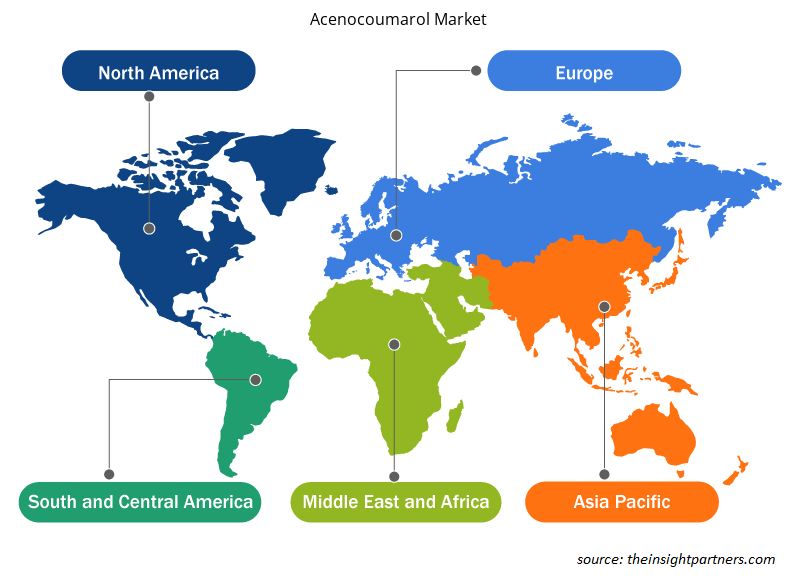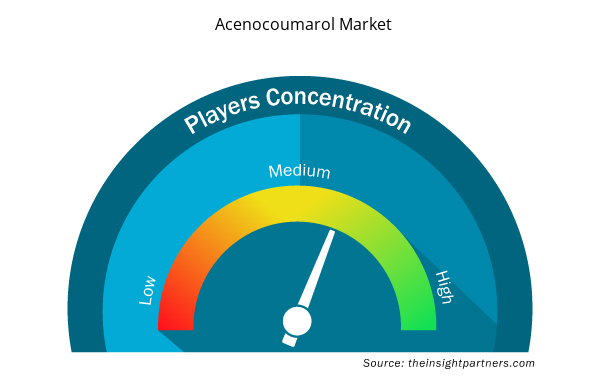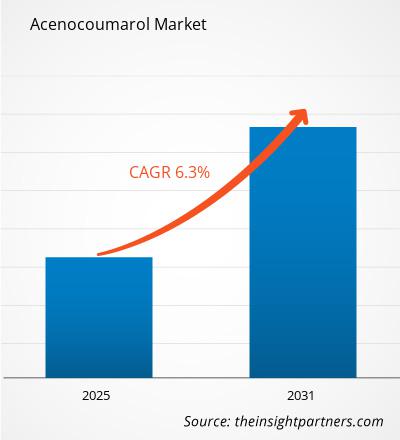The Acenocoumarol Market is expected to register a CAGR of 6.3% from 2025 to 2031, with a market size expanding from US$ XX Million in 2024 to US$ XX Million by 2031.
The research report on the Acenocoumarol Market is segmented by type into tablets and injectables. Applications analyzed include anticoagulant therapy, stroke prevention, and deep vein thrombosis management. End-users include pharmaceutical companies, hospitals, healthcare providers, and clinics. The regional analysis covers key markets such as North America, Europe, Asia Pacific, the Middle East and Africa, and South America. The market evaluation is presented in US$ for all segmental analyses. This report explores the increasing demand for acenocoumarol in anticoagulant therapy, particularly for patients with cardiovascular conditions, and the role of generics in expanding market access.
Purpose of the Report
The report Acenocoumarol Market by The Insight Partners aims to describe the present landscape and future growth, top driving factors, challenges, and opportunities. This will provide insights to various business stakeholders, such as:
- Technology Providers/Manufacturers: To understand the evolving market dynamics and know the potential growth opportunities, enabling them to make informed strategic decisions.
- Investors: To conduct a comprehensive trend analysis regarding the market growth rate, market financial projections, and opportunities that exist across the value chain.
- Regulatory bodies: To regulate policies and police activities in the market with the aim of minimizing abuse, preserving investor trust and confidence, and upholding the integrity and stability of the market.
Acenocoumarol Market Segmentation
Type
- 1 mg
- 2 mg
- 4 mg
Application
- Coronary Occlusions
- Pulmonary Embolism
- Systemic Embolism
- Transient Ischemic Attack
Customize This Report To Suit Your Requirement
You will get customization on any report - free of charge - including parts of this report, or country-level analysis, Excel Data pack, as well as avail great offers and discounts for start-ups & universities
Acenocoumarol Market: Strategic Insights

- Get Top Key Market Trends of this report.This FREE sample will include data analysis, ranging from market trends to estimates and forecasts.
Acenocoumarol Market Growth Drivers
- Increasing Prevalence of Cardiovascular Diseases: Cardiovascular diseases (CVDs) are a significant global health concern, contributing to a surge in demand for anticoagulants like acenocoumarol. According to the World Health Organization (WHO), CVDs are among the leading causes of death worldwide, with diseases such as atrial fibrillation (AF), deep vein thrombosis (DVT), and pulmonary embolism (PE) increasing the incidence of clot-related complications. Acenocoumarol, a well-established oral anticoagulant, is commonly prescribed to manage blood clotting disorders in patients suffering from these conditions. Atrial fibrillation alone, which increases the risk of stroke, is a major contributor to the demand for long-term anticoagulant therapy. With the growing number of aging populations globally, who are more prone to these diseases, the need for consistent and effective anticoagulation therapy has risen. As individuals with cardiovascular risk factors such as hypertension, obesity, and diabetes increase, the demand for acenocoumarol is set to expand. The drug’s ability to reduce the likelihood of strokes, heart attacks, and other cardiovascular complications positions it as a mainstay treatment for patients with CVDs. Furthermore, because acenocoumarol offers a relatively low-cost alternative to newer direct oral anticoagulants (DOACs), especially in developing countries, its popularity remains strong. With continued high prevalence rates of cardiovascular diseases globally, acenocoumarol is expected to remain in demand, propelling the market forward. The increasing risk factors associated with lifestyle changes, such as poor diets, sedentary habits, and smoking, will likely exacerbate the incidence of cardiovascular diseases, further driving the need for reliable anticoagulant therapies like acenocoumarol.
- Growing Awareness about Blood Clotting Disorders: Over the last few decades, there has been a significant increase in the awareness of blood clotting disorders, such as DVT, AF, and PE, which has directly impacted the acenocoumarol market. Public health initiatives and campaigns have made individuals more aware of the risk factors, symptoms, and complications related to blood clots, which has contributed to earlier diagnoses and an increased focus on prevention. As a result, more patients are seeking medical attention for symptoms related to these conditions, and doctors are prescribing anticoagulants, including acenocoumarol, as a preventative measure or to treat existing conditions. The rise in awareness about blood clotting disorders, particularly among at-risk populations such as the elderly, obese, and those with sedentary lifestyles, has increased the patient pool that requires anticoagulation therapy. Education on the potential dangers of untreated blood clots, which can lead to strokes, heart attacks, or even death, has encouraged patients to seek timely medical intervention. With early diagnosis and effective management through drugs like acenocoumarol, healthcare providers can reduce the incidence of severe complications. Additionally, advancements in healthcare technology and research have contributed to a deeper understanding of the mechanisms of clot formation, which has led to better-targeted treatments. These developments, combined with increased healthcare access in both developed and developing nations, will continue to drive the demand for acenocoumarol as a preferred therapy for blood clotting disorders.
- Rising Geriatric Population: The world’s population is aging rapidly, with the proportion of individuals aged 65 and older steadily increasing in many regions, including North America, Europe, and parts of Asia. This demographic shift presents a significant driver for the acenocoumarol market, as the elderly population is particularly vulnerable to cardiovascular diseases and blood clotting disorders. As people age, the risk of developing conditions such as atrial fibrillation, venous thromboembolism (VTE), and other heart-related complications increases, making anticoagulant therapy essential. The World Health Organization predicts that by 2030, one in six people worldwide will be aged 60 or older, and by 2050, this number will rise to one in four. With this population more likely to develop blood clots, acenocoumarol remains a key medication in preventing strokes and other cardiovascular events. Furthermore, older adults often require long-term management of anticoagulation therapy, as they may be at higher risk of recurrent clotting events. Acenocoumarol, which has been used for decades, is well-established in clinical practice for these purposes. Additionally, as the elderly population tends to have multiple comorbidities, the ability to manage blood clotting disorders alongside other age-related diseases makes acenocoumarol a preferred treatment choice. As the geriatric population continues to grow, the need for effective and affordable anticoagulants, like acenocoumarol, will continue to rise, driving market growth.
Acenocoumarol Market Future Trends
- Rising Preference for Home Monitoring and Self-Care: An emerging trend in the acenocoumarol market is the increasing preference for home-based monitoring systems, which allow patients to manage their anticoagulation therapy from the comfort of their homes. Traditionally, patients taking acenocoumarol needed to visit healthcare facilities frequently for INR testing, which could be inconvenient, especially for elderly individuals or those living in remote areas. However, home-based monitoring systems have made it easier for patients to test their INR levels at home, reducing the need for frequent visits to clinics and enhancing patient autonomy. These devices, often paired with mobile apps for tracking and dosage adjustments, are driving a shift toward self-care in anticoagulation therapy. The trend aligns with the broader healthcare shift toward patient-centered care, where individuals take an active role in managing their health. By adopting home monitoring, patients can ensure more consistent therapeutic outcomes and reduce the risk of complications related to anticoagulant therapy. As technology advances, the development of more affordable and user-friendly monitoring tools is expected to further boost the adoption of home-based anticoagulation management, driving the growth of the acenocoumarol market.
- Regulatory Approvals for New Formulations and Combination Therapies: Another key trend in the acenocoumarol market is the development of new formulations and combination therapies that improve the convenience and efficacy of treatment. Traditional acenocoumarol therapy often requires frequent monitoring of INR levels and careful dietary management, which can be cumbersome for patients. As a result, pharmaceutical companies are focusing on developing novel formulations or fixed-dose combinations that simplify the treatment regimen for patients. For example, extended-release formulations of acenocoumarol could potentially reduce the frequency of dosing while maintaining therapeutic efficacy. Additionally, there is growing interest in combining acenocoumarol with other cardiovascular medications in single-dose formulations. These combination therapies would be more convenient for patients who require multiple medications to manage their heart conditions, such as antiplatelet agents or antihypertensives. By streamlining treatment regimens and improving patient compliance, these innovations have the potential to expand the market for acenocoumarol, particularly among elderly patients who often take multiple medications. The development of these new formulations and combinations reflects the ongoing trend toward improving patient adherence and making anticoagulation therapy more convenient.
- Emergence of Direct Oral Anticoagulants (DOACs) as Competitors: While acenocoumarol remains widely used for managing blood clotting disorders, the increasing adoption of direct oral anticoagulants (DOACs) is a notable trend in the market. DOACs, such as rivaroxaban, apixaban, and dabigatran, offer several advantages over acenocoumarol, including fixed dosing schedules, no requirement for regular INR monitoring, and a more predictable pharmacological profile. These advantages have led to a growing preference for DOACs among both healthcare providers and patients. However, acenocoumarol remains a popular choice due to its affordability, particularly in low- and middle-income countries where the cost of DOACs can be prohibitive. Despite the competition from newer anticoagulants, acenocoumarol continues to be favored in these regions due to its lower cost and established safety profile. The rise of DOACs presents a challenge for the acenocoumarol market, but it also drives innovation and improvement in anticoagulation therapies, prompting pharmaceutical companies to explore ways to improve acenocoumarol’s ease of use, such as through combination therapies and more convenient formulations.
Acenocoumarol Market Opportunities
- Development of New Acenocoumarol Formulations: Innovating new formulations of acenocoumarol offers a significant growth opportunity for market expansion. Currently, acenocoumarol is available in tablet form, requiring patients to monitor their INR levels regularly and follow specific dietary restrictions to avoid fluctuations in drug effectiveness. However, there is growing interest in the development of modified-release formulations of acenocoumarol, which could simplify the treatment regimen. Extended-release formulations, for example, would allow patients to take a single dose per day, improving adherence to the therapy and reducing the need for frequent INR monitoring. Additionally, researchers are exploring combination therapies that combine acenocoumarol with other cardiovascular agents, such as antiplatelet drugs or antihypertensives, into a single tablet. These combination treatments could simplify therapy for patients who have multiple conditions, ultimately improving patient compliance and outcomes. By developing new, more convenient formulations of acenocoumarol, pharmaceutical companies can attract a broader patient base and expand market reach. The demand for such innovations will be driven by the need to reduce the complexity of managing anticoagulant therapy and improve patient convenience, especially in older populations who are more likely to require long-term treatment for chronic cardiovascular conditions.
- Partnerships and Collaborations with Healthcare Providers: Strategic partnerships and collaborations with healthcare providers present a unique growth opportunity for expanding the reach of acenocoumarol. Pharmaceutical companies can work with hospitals, clinics, and medical institutions to ensure that acenocoumarol is included in treatment guidelines for managing blood clotting disorders. These collaborations can involve providing training for healthcare professionals on the proper use of acenocoumarol, including how to monitor INR levels and adjust dosages to achieve optimal therapeutic results. Additionally, pharmaceutical companies can work with healthcare organizations to promote awareness campaigns aimed at increasing patient knowledge about the importance of anticoagulation therapy in preventing strokes, heart attacks, and other cardiovascular complications. Such partnerships could also extend to patient support programs that help individuals manage their medication regimen, thereby improving compliance. Furthermore, collaborations with insurance companies can increase the affordability of acenocoumarol for patients by ensuring that the drug is covered under health insurance plans. By fostering partnerships with key stakeholders in the healthcare sector, pharmaceutical companies can improve patient access to acenocoumarol, increase its market share, and strengthen its position as a leading anticoagulant treatment option.
- Generic Acenocoumarol in Low-cost Healthcare Markets: As healthcare systems worldwide strive to reduce costs while maintaining quality care, the demand for generic medications is surging, and acenocoumarol is no exception. Generic drugs offer significant cost savings compared to branded products, which makes them an attractive option for both healthcare providers and patients in cost-conscious markets. In many low- and middle-income countries, where healthcare budgets are limited and the burden of cardiovascular diseases continues to rise, generic acenocoumarol can play a critical role in ensuring access to life-saving anticoagulant therapy. The fact that acenocoumarol has been on the market for several years and is well-established in clinical practice means that there is a large, affordable supply of generic formulations available for use. This makes acenocoumarol a first-line treatment for preventing blood clots and strokes in these regions. Furthermore, as many of these markets are rapidly expanding their healthcare infrastructure, the demand for affordable, reliable, and accessible medications like acenocoumarol is expected to grow. The availability of generic acenocoumarol ensures that patients across different socioeconomic strata can access the medication, improving overall public health outcomes and reducing the economic burden associated with blood clot-related conditions. Pharmaceutical companies can capitalize on this opportunity by increasing the production and distribution of generic acenocoumarol to meet the needs of growing populations in emerging and low-income markets. Additionally, partnerships with local governments and NGOs could help increase access to acenocoumarol, further driving its market growth in these regions.
Acenocoumarol Market Regional Insights
The regional trends and factors influencing the Acenocoumarol Market throughout the forecast period have been thoroughly explained by the analysts at Insight Partners. This section also discusses Acenocoumarol Market segments and geography across North America, Europe, Asia Pacific, Middle East and Africa, and South and Central America.

- Get the Regional Specific Data for Acenocoumarol Market
Acenocoumarol Market Report Scope
| Report Attribute | Details |
|---|---|
| Market size in 2024 | US$ XX Million |
| Market Size by 2031 | US$ XX Million |
| Global CAGR (2025 - 2031) | 6.3% |
| Historical Data | 2021-2023 |
| Forecast period | 2025-2031 |
| Segments Covered |
By Type
|
| Regions and Countries Covered | North America
|
| Market leaders and key company profiles |
Acenocoumarol Market Players Density: Understanding Its Impact on Business Dynamics
The Acenocoumarol Market market is growing rapidly, driven by increasing end-user demand due to factors such as evolving consumer preferences, technological advancements, and greater awareness of the product's benefits. As demand rises, businesses are expanding their offerings, innovating to meet consumer needs, and capitalizing on emerging trends, which further fuels market growth.
Market players density refers to the distribution of firms or companies operating within a particular market or industry. It indicates how many competitors (market players) are present in a given market space relative to its size or total market value.
Major Companies operating in the Acenocoumarol Market are:
- Mylan NV
- SunPharmaceuticalIndustriesLtd
- NovartisAG
- MacleodsPharmaceuticalsLtd
- PharmaSwiss
- MerusLabsInternationalInc
Disclaimer: The companies listed above are not ranked in any particular order.

- Get the Acenocoumarol Market top key players overview
Key Selling Points
- Comprehensive Coverage: The report comprehensively covers the analysis of products, services, types, and end users of the Acenocoumarol Market, providing a holistic landscape.
- Expert Analysis: The report is compiled based on the in-depth understanding of industry experts and analysts.
- Up-to-date Information: The report assures business relevance due to its coverage of recent information and data trends.
- Customization Options: This report can be customized to cater to specific client requirements and suit the business strategies aptly.
The research report on the Acenocoumarol Market can, therefore, help spearhead the trail of decoding and understanding the industry scenario and growth prospects. Although there can be a few valid concerns, the overall benefits of this report tend to outweigh the disadvantages.
- Historical Analysis (2 Years), Base Year, Forecast (7 Years) with CAGR
- PEST and SWOT Analysis
- Market Size Value / Volume - Global, Regional, Country
- Industry and Competitive Landscape
- Excel Dataset



Report Coverage
Revenue forecast, Company Analysis, Industry landscape, Growth factors, and Trends

Segment Covered
This text is related
to segments covered.

Regional Scope
North America, Europe, Asia Pacific, Middle East & Africa, South & Central America

Country Scope
This text is related
to country scope.
Frequently Asked Questions
The Acenocoumarol Market is expected to register a CAGR of 6.3% from 2025-2031.
The major driving factors supporting the Acenocoumarol Market growth are- Increasing Prevalence of Cardiovascular Diseases, Growing Awareness about Blood Clotting Disorders, and Rising Geriatric Population.
Key Future Trends in the Acenocoumarol Market are- Rising Preference for Home Monitoring and Self-Care, Regulatory Approvals for New Formulations and Combination Therapies, and Emergence of Direct Oral Anticoagulants (DOACs) as Competitors.
Key companies in Acenocoumarol Market are - Mylan NV, SunPharmaceuticalIndustriesLtd, NovartisAG, MacleodsPharmaceuticalsLtd, PharmaSwiss, MerusLabsInternationalInc, PolfaWarszawa, AurobindoPharma, TakedaPharmaceuticalCompanyLimited
The report can be delivered in PDF/PPT format; we can also share excel dataset based on the request.
Some of the customization options available based on request are additional 3–5 company profiles and country-specific analysis of 3–5 countries of your choice. Customizations are to be requested/discussed before making final order confirmation, as our team would review the same and check the feasibility.
Trends and growth analysis reports related to Life Sciences : READ MORE..
1. Mylan N.V.
2. Sun Pharmaceutical Industries Ltd.
3. Novartis AG
4. Macleods Pharmaceuticals Ltd.
5. PharmaSwiss
6. Merus Labs International Inc. (Norgine B.V.)
7. Polfa Warszawa
8. Aurobindo Pharma.
9. Takeda Pharmaceutical Company Limited
10. Neiss Labs Ltd.

 Get Free Sample For
Get Free Sample For